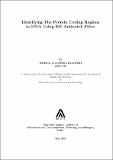Please use this identifier to cite or link to this item:
http://drsr.daiict.ac.in//handle/123456789/156| Title: | Identifying the protein coding regions in DNA using IIR antinotch filter |
| Authors: | Chakka, Vijaykumar Sahasrabudhe, S.C Grandhi, Durga Ganesh |
| Keywords: | Cellular signal transduction Genetic regulation Control theory Gene Expression Regulation physiology Genomics Models Theoretical Signal Transduction Genetics Protein coding DNA |
| Issue Date: | 2007 |
| Publisher: | Dhirubhai Ambani Institute of Information and Communication Technology |
| Citation: | Grandhi, Durga Ganesh (2007). Identifying the protein coding regions in DNA using IIR antinotch filter. Dhirubhai Ambani Institute of Information and Communication Technology, vii, 32 p. (Acc.No: T00119) |
| Abstract: | Genomic Signal Processing is an emerging interdisciplinary area. The problem of Identifying Protein Coding Regions in DNA is addressed using signal processing techniques in this work. DNA can be thought of a string formed from the alphabet set A = {A,C,G, T}. It is found that in protein coding regions the symbols have periodicity of 3 [Trifonov and Sussman, 1980], known as period-3 property. In genomic signal processing, this periodicity is used as a cue, to identify the protein coding regions using signal processing techniques like Discrete Fourier Transform (DFT) and Digital Filtering. This is possible only if the symbol sequences are mapped to numbers. In this thesis it is identified that the computational complexity of the filters employed for identifying the protein coding regions presented in the DNA, is directly related to the choice of mapping. A new lower dimensional mapping is also proposed which reduces the computational complexity by half, producing results nearly equal to those produced by a higher dimensional mapping. |
| URI: | http://drsr.daiict.ac.in/handle/123456789/156 |
| Appears in Collections: | M Tech Dissertations |
Files in This Item:
| File | Description | Size | Format | |
|---|---|---|---|---|
| 200511026.pdf Restricted Access | 424.79 kB | Adobe PDF |  View/Open Request a copy |
Items in DSpace are protected by copyright, with all rights reserved, unless otherwise indicated.
